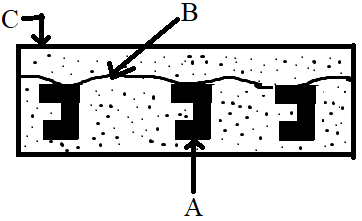This set of Building Construction Multiple Choice Questions & Answers (MCQs) focuses on “Types of Partitions – 1”.
1. Which of the following is not a type of partition wall?
a) Brick partitions
b) Glass partitions
c) Gum partitions
d) Concrete partitions
View Answer
Explanation: A partition wall is a type of wall which is used to divide the space within the building. It is of the following types – brick partitions, glass partitions, concrete partitions, metal lath partitions, plaster slab partitions, timber partitions, etc.
2. Which of the following is an important requirement in the design of internal walls?
a) Thermal insulation
b) Sound insulation
c) Weather exclusion
d) Heat
View Answer
Explanation: Sound insulation is an important requirement in the design of internal walls. An internal wall is a load-bearing partition wall. Strength is also an important factor in the design of internal walls.
3. Partition walls are load-bearing walls.
a) True
b) False
View Answer
Explanation: Partition walls can be either load-bearing or non-load bearing. Partition walls are generally non-load bearing walls.
4. A partition wall should be _______
a) Heavy and thick
b) Light and thick
c) Light and thin
d) Light and thick
View Answer
Explanation: A partition wall should be as light and as thin as possible. Lighter the partitions, the lighter will be the structural elements. This will result in a better economy of the building.
5. Which of the following is a requirement which must be filled by partition walls?
a) A partition wall should be heavy
b) A partition wall should be fire resistant
c) A partition wall should be thick
d) A partition wall may not act as a sound barrier
View Answer
Explanation: Some of the requirements that must be filled by partition walls are they should be light and thin. They must act as a sound barrier. They should be fire resistant and strong enough to carry their own load.
6. Hollow clay blocks used for clay block partition walls are not _________
a) Good insulator of heat
b) Good conductor of heat
c) Good insulator of sound
d) Fire-resistant
View Answer
Explanation: For the construction of clay block partition walls, hollow clay blocks may be used. They are good insulators of heat and sound. They are also fire-resistant.
7. In hollow clay blocks used for clay block partition walls ___________ serve as a key to plaster.
a) Grooves
b) Frog
c) Arris
d) Kick
View Answer
Explanation: In hollow clay blocks used for clay block partition walls, grooves serve as a key to plaster. Grooves are provided on the top, bottom and sides of the blocks. A frog is an indentation in the brick for holding the mortar. An arris is an edge of a brick. A kick is another term used for a frog.
8. In concrete partitions, concrete mix adopted for precast slab units is _________
a) M 10
b) M 15
c) M 20
d) M 25
View Answer
Explanation: In concrete partitions, concrete mix adopted for precast slab units is usually M 15. In M 15, M denotes Mix and 15 is the characteristic compressive strength of concrete cube at 28 days in N/mm2.
9. The thickness of cast-in-situ concrete partitions is generally ___________
a) 80-100 mm
b) 80-100 cm
c) 40-60 mm
d) 40-60 cm
View Answer
Explanation: The thickness of cast-in-situ concrete partitions is generally 80-100 mm. They are rigid and stable. However, they require large costs for their construction.
10. The thickness of precast concrete partitions is generally ___________
a) 10-15 mm
b) 25-40 mm
c) 50-80 mm
d) 45-60 mm
View Answer
Explanation: Concrete partitions consist of slabs which may be either precast or cast-in-situ. The thickness of precast concrete partitions is generally 25-40 mm. They are lighter than the cast-in-situ partitions.
11. In precast concrete partitions ___________ is used for jointing.
a) Mud mortar
b) Lime mortar
c) Cement mortar (1:3)
d) Cement mortar (1:2)
View Answer
Explanation: In precast concrete partitions, generally, cement mortar (1:3) is used for jointing. Precast T-shaped or L-shaped units are used for concrete partitions and a lightweight partition is obtained.
12. In metal lath partitions, vertically placed channels are called as _________
a) Piers
b) Piles
c) Studs
d) Grooves
View Answer
Explanation: In metal lath partitions, channels are placed vertically which are called studs. They can be 2 cm or 2.5 cm in length. Metal lath is fixed to it on one of its sides.
13. What is the distance between the channels placed in metal lath partitions?
a) 15-30 cm
b) 5-10 cm
c) 10-15 cm
d) 40-50 cm
View Answer
Explanation: The distance between the channels placed in metal lath partitions is usually 15-30 cm. The thickness of the partition generally varies between 5 and 7.5 cm.
14. In metal lath partitions __________ wire is used for tying metal lath to channels.
a) Silver
b) Copper
c) Galvanized iron
d) Aluminium
View Answer
Explanation: In metal lath partitions, a galvanized iron wire is used for tying metal lath to channels. Metal lath partitions are strong and thin. They have high durability and are fire resistant.
15. In the figure given below, A represents _________

a) Metal lath
b) Channel
c) Plaster
d) Concrete
View Answer
Explanation: The given figure represents a metal lath partition for a solid wall. Here, A represents a channel, B represents metal lath and C represents plaster.
Sanfoundry Global Education & Learning Series – Building Construction.
To practice all areas of Building Construction, here is complete set of 1000+ Multiple Choice Questions and Answers.
If you find a mistake in question / option / answer, kindly take a screenshot and email to [email protected]
- Apply for Civil Engineering Internship
- Check Civil Engineering Books
- Check Construction and Building Materials Books
- Practice Civil Engineering MCQs
